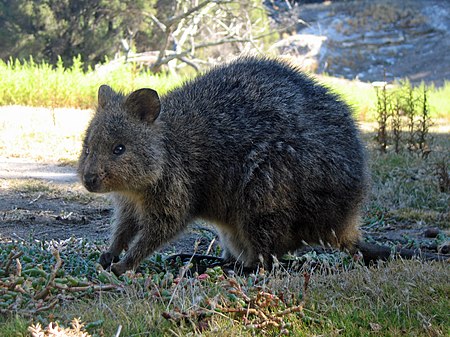Template:Species-2013-08
Species of the month
editQuokka
editSome facts on this marsupial:
Head and body length: 40 to 54 cm.
Weight: 2.4 to 4.2 kg.
Distribution: Rottnest Island, south-west Western Australian mainland.
Habitat: Dense swamps, heath, thickets, low forest and waterside areas.
Diet: Native grasses and the leaves, stems and bark of a variety of plants.
Surviving number: 8,000–17,000 mature individuals.
Protection status: Vulnerable (IUCN 3.1).
First described: By the French zoologists, Jean René Constant Quoy and Joseph Paul Gaimard in 1830 as Kangurus brachyurus.
Setonix brachyurus carries a spare baby. The female has a safeguard in the case that her joey dies: it has a pre-embryonic structure called a blastocyst, which develops into an embryo if she loses her offspring before becoming independent enough to leave the pouch. The quokka harbors special bacteria in its gut, capable of breaking down poor-quality vegetation into usable nutrients. This little marsupial is terrestrial yet is able to climb trees and small shrubs. It browses for leaves and grasses and searches out the best shelter from the summer scorching sun. All its natural advantages are of little help against the abundant threats it faces: foxes, feral cats, habitat loss and disease.
See also: Species of previous months
